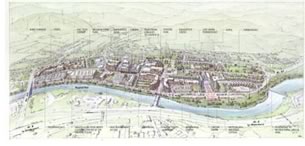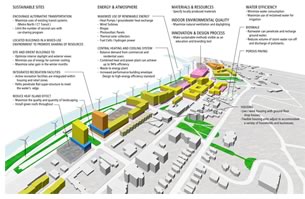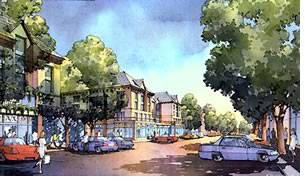

05/2005
Fox & Fowle to serve as master planner
by Heather Livingston
Naugatuck, Conn., has unveiled plans to redevelop 60 acres in the heart of its historic downtown. As master planners for Renaissance Place, New York City’s Fox & Fowle Architects will oversee the region’s first energy-independent redevelopment project. Renaissance Place will transform an underused downtown corridor into a vibrant live/work/play environment with residences, retail, restaurants, entertainment, and businesses. According to Mark Strauss, the firm’s director of planning, “Although development will not happen overnight, Naugatuck has the potential to become a thriving regional center with high-quality multifamily residences, retail, office, and public green space—all while being at the forefront of sustainable design by achieving energy independence.”
 A little history
A little history
Originally settled as a farming community, Naugatuck (an Algonquin word that means “lone tree by the fishing place”) inhabitants soon realized that the terrain and soil were better suited for manufacturing and commercial endeavors. Early manufacturing relied on the Naugatuck River for power, but the expansion of the railroads soon meant that coal became the dominant power supply. Wealthy industrialists expanded and improved the borough’s physical infrastructure by commissioning schools, churches, libraries, offices, and other facilities. Among Naugatuck’s architectural treasures are the Congregational Church and the Hillside School, by McKim, Mead and White, and the Naugatuck Railroad Station, by Henry Bacon.
Transportation and downtown amenities
The borough hopes to enliven its downtown by attracting residents eager to take advantage of urban amenities—young professionals, empty nesters, and seniors. Renaissance Place will offer market-rate housing and high-quality retail and services, with active recreation facilities integrated within those areas.
 To encourage pedestrian activity, lower the heat-island effect, and beautify the city, both new and existing streets will be infused with attractive landscaping and easy riverfront access. Development will be organized within walking distance of mass-transit, with the greatest density encouraged adjacent to transit centers. The plan aims to reduce automobile dependence by incorporating a car-sharing program and offering fast, reliable, and comfortable transit service. Access to various modes of transportation will also be enhanced, including fully enclosed bicycle parking at transit stops. Downtown roadways will be designed to calm traffic and limit automobile speeds, considerations that put foremost the convenience of the pedestrian, not the car. In addition, the hybrid and alternative-energy vehicles used during construction will be made available to residents.
To encourage pedestrian activity, lower the heat-island effect, and beautify the city, both new and existing streets will be infused with attractive landscaping and easy riverfront access. Development will be organized within walking distance of mass-transit, with the greatest density encouraged adjacent to transit centers. The plan aims to reduce automobile dependence by incorporating a car-sharing program and offering fast, reliable, and comfortable transit service. Access to various modes of transportation will also be enhanced, including fully enclosed bicycle parking at transit stops. Downtown roadways will be designed to calm traffic and limit automobile speeds, considerations that put foremost the convenience of the pedestrian, not the car. In addition, the hybrid and alternative-energy vehicles used during construction will be made available to residents.
 Energy independence
Energy independence
Designed to be an energy-independent demonstration project, sustainable technologies abound throughout the plan. Buildings will be oriented to optimize interior daylight and exterior views, minimize energy use during summer months, and maximize solar gain during the winter. Green roofs will be installed throughout Renaissance Place to help manage storm-water runoff, cool the local environment, and reduce energy use. A variety of renewable-energy technologies will be used, including wind turbines, biogas, photovoltaic panels, thermal solar collectors, and fuel cells/hydrogen power. Additional sustainable strategies include incorporating porous paving, using locally produced materials, and maximizing natural ventilation and daylighting.
The Renaissance Place development team reports that the project is part of a vital initiative to promote energy independence to improve national security and enhance the well being and prosperity of the borough’s citizens. Upon completion, the project will also include a technology center that will showcase the development and implementation of energy-independent technologies. Planned in stages, the first phase is designed to attract investors, increase transit use, and promote community economic development. The initial phase will deliver new public green spaces and roads, improved gateways, more than 500 new apartments, and 220,000 square feet of retail space. Future development may include 1,700 apartments, townhouses, and live-work lofts; 500,000 square feet of retail space; and three hotels. Construction is set to begin in early 2007.
Copyright 2005 The American Institute of Architects.
All rights reserved. Home Page ![]()
![]()
 |
||
The Development Team Did you know? Naugatuck’s most famous native son is Charles Goodyear, the inventor who perfected the vulcanized rubber process. Other celebrated natives include Harris Whittemore Jr., president of Colonial Air Transport, Inc., the first airline to be awarded a federal airmail contract, and Frank “Spec” Shea, a Major League Baseball pitcher for the New York Yankees (1947–1957) and the Washington Nationals/Senators (1952–1955). The largest employer in Naugatuck is the Hershey’s Peter Paul Candy Company. Founded in New Haven, Conn., the company moved to Naugatuck in 1922. Originally sold door-to-door the morning after they were prepared, today every Almond Joy® and Mounds® candy bar is made in Naugatuck. All images courtesy of the architect.
|
||